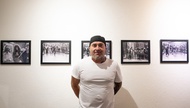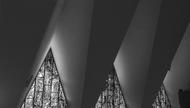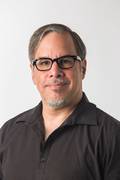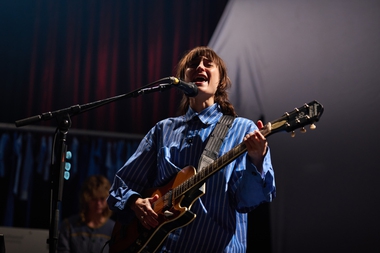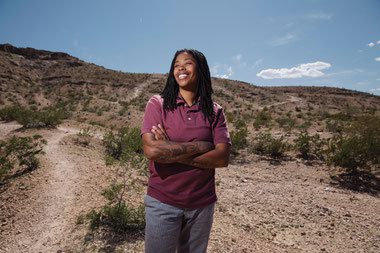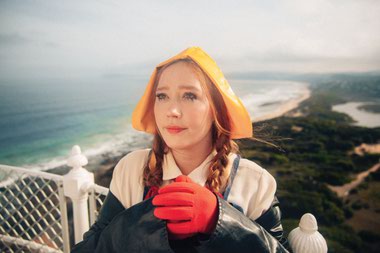Krystal Ramirez and I are having a somewhat awkward conversation. Not uncomfortable; just … weird. A photographer and, for want of a better term, text artist—her pieces manipulate language in ways similar to Jenny Holzer and Christopher Wool, though she has her own distinct style—Ramirez is one of Las Vegas’ more audacious visual talents, certainly worthy of a feature piece. But at the same time, we’ve known each other for nearly seven years, worked together for part of it—and our conversations have always been a little bit like interviews, as we’re inclined toward heavy discussions about art and identity. It makes sense that our first proper interview would feel a bit like hangin’ out.
But I want to know what makes that art happen. Language is how I make a living—and Ramirez does things with words that change the way I look at them. (You can see it in one of her permanent installations at Downtown’s Eat; the wall-size piece repeats the haunting mantra “I’ll see you in the flowers,” taking it from joy to despair and back.) Krystal’s only in town for a brief time—soon she’ll return to Stanford University, where she’s a candidate in the Fine Arts program in Art Practice—so we took a distanced stroll through the Arts District, talking about art and identity, like always.
We’ll start off easy. Favorite color? Yellow.
Why? I know yellow can be really off-putting, because we’re accustomed to seeing it as a color alerting us to construction, or to caution in general. But it makes me think of the sun, and of The Yellow Wallpaper by Charlotte Perkins Gilman. It’s about a woman whose house is wallpapered with a yellow pattern all over, and she goes mad. I mean, it can be a high anxiety-inducing color … but I do like the alertness that the color inspires. It has a brightness that’s overwhelming. It stops you in your tracks. It also reminds me of my dad, who worked in construction and wore that safety fluorescent yellow. That was his uniform.
My work leans toward obstruction and minimalism, you know, so I started adding color. Naturally, the first color that made the most sense to add was yellow, because of my relationship to it.
Is your work intended to be cautionary? I’m not cautioning, but I do like the alertness that the color causes. I’m trying to create spaces where you’re hyperaware of your body or your thinking process. I want you to feel like you’re in between worlds.
You’re a Mexican American artist. In this polarized and racially charged time, do those two worlds feel separate to you? Subconsciously, I’ve always been aware of my brownness, but when I first started making art, I wasn’t thinking, like, “Let me make work about my Mexican American identity.” But one thing that I’ve kind of come to realize is that it’s so much better to make work from your direct experience than to try to make work about a larger social or cultural experience. When I make personal work, all those larger conversations are inherently in the work, because I’m a brown woman. I’m making work about my very direct experience, which is like, duh, I can’t believe it took me 10 years of making art and applying to grad school to figure that one out.
What’s your first love—language or photography? Photography is definitely my first love. The first photography class I took in school as an art requirement is what made me want to switch to an art major. I loved the idea of freezing the world around me, always documenting. I really fell in love with visual language.
I’ve been asking myself why I’m specifically obsessed with words and language and text—and I think one of the reasons is because Nevada is one of the lowest states in the union for education. There’s always this … I don’t know if it’s a fear or awareness of the quality of education I received. I had great teachers; I had people who cared for me a lot. But my parents really were not in a position to get me tutors or to sit with me with my homework. So, there’s this obsession in me to try to conquer language. I’m trying to get people to question the language they’re using and to understand that language is just as subjective as anything else.
And language has a shape, an architecture that’s pleasing to the eye. That’s intuitively what I felt attracted to. And it probably has to do with growing up in Vegas and its signs, its visual language. There’s language and typography everywhere you look. That’s one of the realizations I had in speaking with my adviser: “Oh, I bet all this marketing and advertising and the topography of the visual landscape here in Vegas totally influenced so much of my work.” It took me leaving Las Vegas to realize that.
Were you also influenced by Vegas artists? Wendy Kveck is a mentor and friend. She’s so inspiring. I love her work, and I love her commitment to her community. I probably wouldn’t be an artist today if it wasn’t for her. I had my first solo show in 2013, and she was in charge of putting it up; she was a coordinator at the Winchester and the [Clark County] Government Center. She was committed to diversifying the artist pool, and she called me and said, “You need to submit [your work] to this. I’m going to walk you through the application.” She held my hand through it, because you don’t really learn a lot of that real-life stuff in art school, which is a fault. And my show was chosen. It was a hot mess, but I did it, and I’m proud of it. And after that, I kind of just kept making work, because I was like, “Oh, this is fun. This is what I wanted to do.”
You count a bunch of prominent Las Vegas artists—Justin Favela, Jen Kleven, Lance Smith and Mikayla Whitmore—among your close friends. Do you guys have a friendly competition going or what? Oh, yeah. For sure. I wouldn’t be where I am now if it wasn’t for Favy, Mikayla, Jen and Lance, but I’m also a competitive person. I don’t like to be left behind. If my friends get something, I’m like, “Well, I want to do that, too.” But we’re always 150% there for each other, supporting each other. You can be competitive with somebody in a friendly way, but if you’re not careful, it could turn unhealthy or toxic. So, you get to a point where you just have to accept each other’s paths. There’s room for all of us.
If you could gift your hometown art community something big, what would it be? Better arts funding for K-12 schools. Speaking as a child of blue-collar workers, that kind of teaching is what makes kids aware that there are other opportunities in life. That’s why I love the Barrick [Museum]. Alisha Kerlin is a hero; her Bus to the Barrick program brings K-12 kids to see art exhibits. It’s so, so important for kids to have that at an early age.

